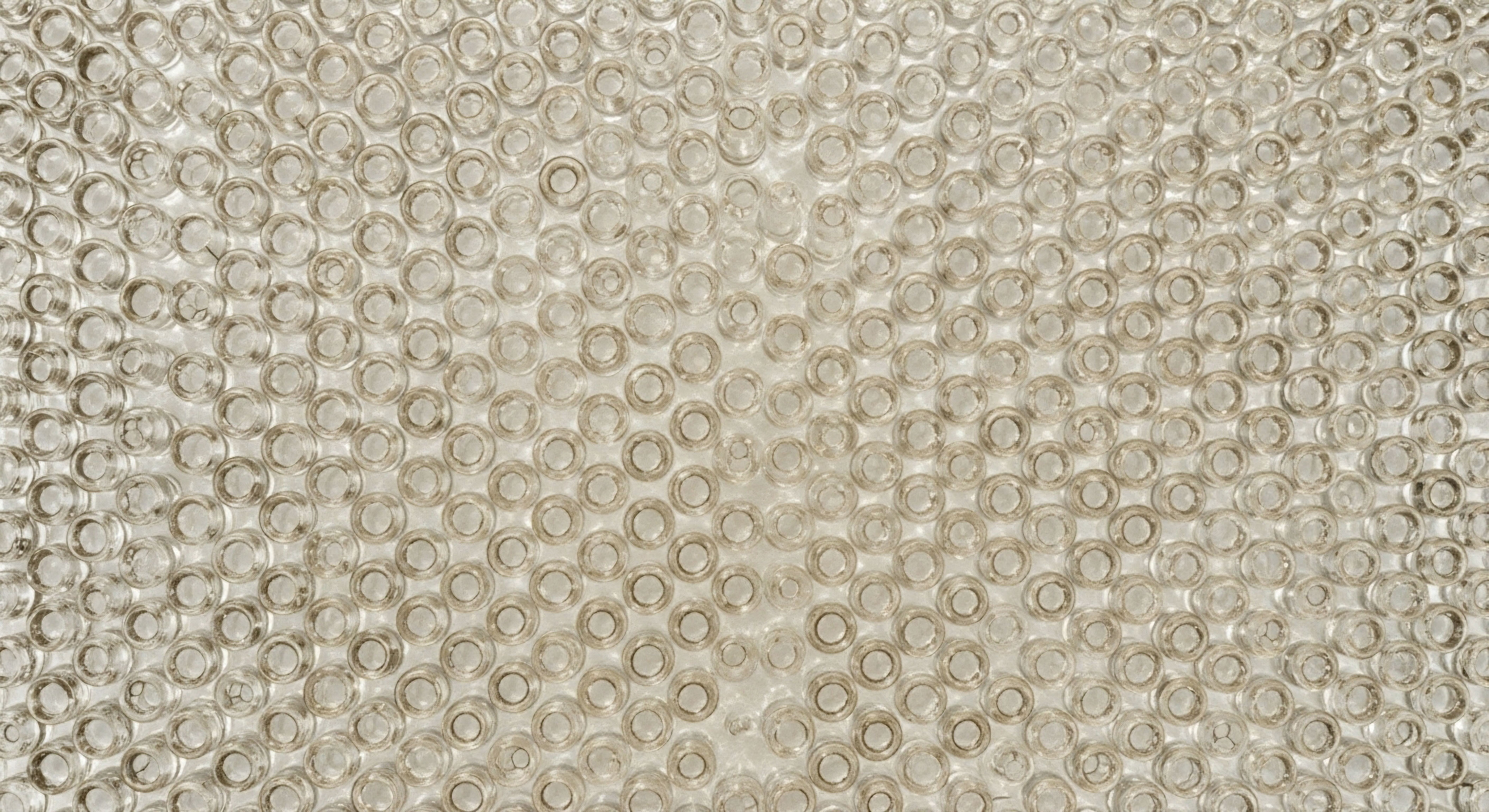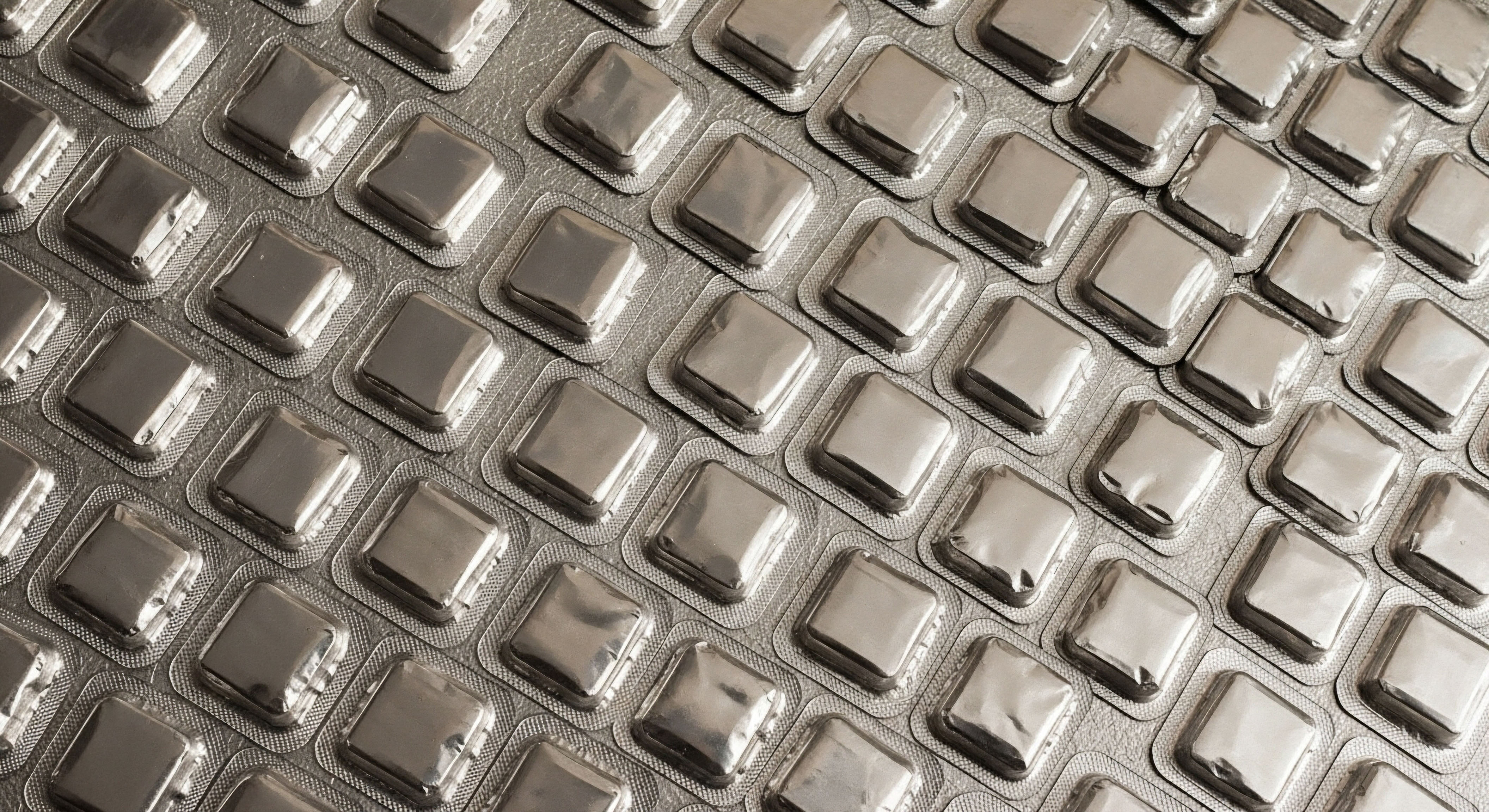

Fundamentals
When you find yourself navigating the subtle shifts in your body, perhaps a persistent fatigue that shadows your days, a quiet decline in your drive, or a sense that your vitality has dimmed, it is natural to seek explanations. These experiences are not merely isolated occurrences; they are often whispers from your intricate biological systems, signaling a need for attention.
For many men, these feelings can point to changes within their hormonal landscape, specifically concerning testosterone levels. As we consider optimizing hormonal health, a significant and deeply personal aspect often arises ∞ the preservation of fertility. This concern is valid and deserves a thorough, empathetic exploration, as the decision to pursue hormonal optimization protocols carries implications for future reproductive potential.
Understanding your body’s internal messaging system is the first step toward reclaiming function. The hypothalamic-pituitary-gonadal axis (HPG axis) serves as the central command center for male reproductive health, orchestrating the production of testosterone and sperm.
This sophisticated feedback loop involves three key players ∞ the hypothalamus in the brain, which releases gonadotropin-releasing hormone (GnRH); the pituitary gland, which responds to GnRH by secreting luteinizing hormone (LH) and follicle-stimulating hormone (FSH); and the testes, which produce testosterone and sperm under the influence of LH and FSH, respectively.
When exogenous testosterone, such as that used in testosterone replacement therapy (TRT), is introduced into the body, the HPG axis perceives an abundance of testosterone. This perception triggers a natural, self-regulating mechanism ∞ the brain reduces its own production of GnRH, which in turn diminishes the pituitary’s release of LH and FSH.
With reduced LH and FSH signaling, the testes receive fewer instructions to produce their own testosterone and, critically, to generate sperm. This suppression of the HPG axis can lead to a significant decrease in sperm count, potentially resulting in temporary or, in some cases, persistent infertility.
Hormonal optimization protocols, while beneficial for vitality, can impact male fertility by signaling the body to reduce its natural sperm production.
The prospect of diminished fertility can be a source of considerable concern for individuals considering hormonal optimization, particularly for younger men or those who envision future parenthood. It is essential to acknowledge this concern, not as a barrier, but as a critical element of a comprehensive health discussion.
The goal is to provide clarity and options, ensuring that decisions about hormonal health align with your broader life aspirations. This involves a careful consideration of biological mechanisms, therapeutic strategies, and the legal and ethical frameworks that guide fertility preservation.

Why Does Hormonal Optimization Affect Fertility?
The body’s endocrine system operates on a principle of intricate balance, akin to a finely tuned thermostat. When external testosterone is introduced, the system detects sufficient levels of the hormone, prompting it to dial down its internal production. This regulatory action, known as negative feedback, directly impacts the testes’ ability to produce sperm.
While the circulating testosterone levels may rise, the critical local testosterone concentrations within the testes, which are essential for robust spermatogenesis, can decline significantly due to the suppressed LH and FSH signals.
This physiological response means that while TRT can alleviate symptoms of low testosterone, it concurrently acts as a form of male contraception. The impact can range from a reduced sperm count, known as oligospermia, to a complete absence of sperm, termed azoospermia. The duration and dosage of exogenous testosterone can influence the degree of suppression, and while sperm production often recovers after discontinuing therapy, this recovery is not universally guaranteed for every individual.


Intermediate
For individuals considering hormonal optimization who also wish to preserve their reproductive potential, clinical science offers targeted strategies. These protocols aim to mitigate the suppressive effects of exogenous testosterone on the HPG axis, or to stimulate natural hormonal pathways that support spermatogenesis. The objective is to achieve hormonal balance and symptom improvement without compromising the ability to conceive.

What Clinical Protocols Support Fertility during Male Hormone Therapy?
A cornerstone of fertility preservation in men undergoing testosterone therapy involves the strategic use of specific medications that work to maintain the integrity of the HPG axis. These agents function by either mimicking natural hormones or by modulating the body’s feedback loops to encourage endogenous testosterone and sperm production.

Gonadorelin in Fertility Preservation
Gonadorelin, a synthetic form of the naturally occurring gonadotropin-releasing hormone (GnRH), plays a significant role in maintaining testicular function and fertility during TRT. When administered in a pulsatile fashion, similar to the body’s natural release, gonadorelin stimulates the pituitary gland to secrete LH and FSH. These gonadotropins then act directly on the testes, prompting them to continue producing both testosterone and sperm. This approach helps to counteract the testicular shrinkage and spermatogenic suppression commonly associated with exogenous testosterone administration.
The careful titration of gonadorelin allows for the preservation of intratesticular testosterone levels, which are crucial for sperm development, while still allowing for the benefits of systemic testosterone optimization. This dual action makes gonadorelin a valuable tool for younger men or those who prioritize maintaining their fertility options.

Anastrozole and Hormonal Balance
Anastrozole, an aromatase inhibitor, is another medication utilized in male hormone therapy, primarily to manage elevated estrogen levels that can arise from the conversion of testosterone. While its main role is to prevent side effects such as gynecomastia or water retention, it can also indirectly support fertility.
By reducing the conversion of testosterone to estrogen, anastrozole helps maintain a more favorable testosterone-to-estradiol ratio. Elevated estrogen can exert negative feedback on the HPG axis, further suppressing LH and FSH. By mitigating this effect, anastrozole can contribute to a healthier hormonal environment conducive to sperm production.
Strategic medication use, including gonadorelin and anastrozole, can help men on testosterone therapy maintain fertility by supporting natural hormonal pathways.

Enclomiphene for Endogenous Stimulation
Enclomiphene citrate is a selective estrogen receptor modulator (SERM) that offers a distinct advantage for fertility preservation. Unlike exogenous testosterone, enclomiphene works by blocking estrogen receptors in the hypothalamus and pituitary gland. This blockade prevents estrogen from exerting its negative feedback, thereby increasing the pulsatile release of GnRH, and subsequently, LH and FSH from the pituitary. The elevated LH and FSH then stimulate the testes to produce more endogenous testosterone and sperm.
Enclomiphene is particularly appealing for men with secondary hypogonadism who desire to maintain or improve their sperm production, as it raises testosterone levels without directly suppressing the HPG axis. This makes it a fertility-friendly option for many individuals.

Tamoxifen and Clomid for Fertility Restoration
Tamoxifen and Clomid (clomiphene citrate), also SERMs, have been used off-label for decades to treat male infertility and secondary hypogonadism. Their mechanism of action is similar to enclomiphene ∞ they block estrogen receptors, leading to increased LH and FSH secretion and subsequent stimulation of testicular function.
These medications can improve sperm concentration and motility, and are often considered for men who have discontinued TRT and are seeking to restore their natural fertility, or as an alternative to TRT when fertility is a primary concern.
The choice among these agents depends on individual patient profiles, the degree of HPG axis suppression, and specific fertility goals. A personalized approach, guided by comprehensive hormonal assessments, is paramount.

Sperm Cryopreservation as a Proactive Measure
Beyond pharmacological interventions, sperm cryopreservation, or sperm banking, stands as a highly effective and established method for fertility preservation. This procedure involves collecting and freezing semen samples for future use. It is a proactive measure that provides a safeguard for reproductive potential, particularly for men initiating treatments that may irreversibly impair fertility, such as certain cancer therapies or long-term, high-dose exogenous testosterone protocols where recovery of spermatogenesis is uncertain.
The process typically involves collecting multiple samples to ensure sufficient quantity and quality of sperm are stored. These samples can then be used in various assisted reproductive technologies (ART) later, such as intrauterine insemination (IUI) or in vitro fertilization (IVF) with intracytoplasmic sperm injection (ICSI).
| Agent | Mechanism of Action | Primary Benefit for Fertility | Common Use Case |
|---|---|---|---|
| Gonadorelin | Mimics GnRH, stimulates pituitary LH/FSH release. | Maintains endogenous testosterone and sperm production, prevents testicular atrophy. | Concurrent use with TRT to preserve fertility. |
| Anastrozole | Aromatase inhibitor, reduces testosterone-to-estrogen conversion. | Indirectly supports fertility by optimizing testosterone/estradiol ratio, reducing negative feedback. | Managing elevated estrogen during TRT, or for men with high estrogen-to-testosterone ratios. |
| Enclomiphene | SERM, blocks estrogen receptors in hypothalamus/pituitary, increases LH/FSH. | Stimulates natural testosterone and sperm production without exogenous testosterone. | Alternative to TRT for men desiring fertility, or for secondary hypogonadism. |
| Tamoxifen / Clomid | SERMs, block estrogen receptors, increase LH/FSH. | Improves sperm parameters and testosterone levels. | Fertility restoration post-TRT, or as primary treatment for idiopathic male infertility. |

How Do We Navigate the Ethical Landscape of Fertility Preservation?
The decision to preserve fertility, especially in the context of medical interventions like hormone therapy, is not solely a clinical one; it is deeply intertwined with ethical and legal considerations. These discussions require a framework that prioritizes patient autonomy, informed decision-making, and the long-term implications of such choices.
One primary ethical consideration revolves around informed consent. Individuals must receive comprehensive information about the potential impact of hormone therapy on their fertility, the available preservation options, the success rates, costs, and the long-term storage implications of cryopreserved samples. This discussion should be clear, unbiased, and tailored to the individual’s understanding, ensuring they can make a truly autonomous decision about their reproductive future.


Academic
The intersection of male hormone therapy and fertility preservation presents a complex landscape, demanding a deep understanding of endocrinology, reproductive physiology, and the evolving legal and ethical frameworks. Our exploration moves beyond the foundational concepts to dissect the intricate biological mechanisms and the societal implications that shape clinical practice.

Dissecting the Hypothalamic-Pituitary-Gonadal Axis Suppression
The suppressive effect of exogenous testosterone on spermatogenesis is a direct consequence of its influence on the hypothalamic-pituitary-gonadal (HPG) axis. This neuroendocrine axis operates through a sophisticated negative feedback loop. The hypothalamus, acting as the primary neuroendocrine transducer, releases gonadotropin-releasing hormone (GnRH) in a pulsatile manner. This pulsatility is critical; continuous GnRH stimulation can paradoxically desensitize the pituitary. GnRH then stimulates the anterior pituitary to secrete luteinizing hormone (LH) and follicle-stimulating hormone (FSH).
In the testes, LH primarily acts on the Leydig cells to stimulate testosterone production, while FSH, in concert with testosterone, acts on the Sertoli cells to support spermatogenesis. Exogenous testosterone elevates systemic androgen levels, which the hypothalamus and pituitary detect.
This detection leads to a reduction in GnRH pulse frequency and amplitude, and a direct suppression of LH and FSH release from the pituitary. The resultant decline in intratesticular testosterone, which is orders of magnitude higher than circulating levels and indispensable for germ cell maturation, is the direct cause of impaired spermatogenesis, often leading to azoospermia.
Exogenous testosterone disrupts the HPG axis, reducing crucial intratesticular testosterone levels necessary for robust sperm production.
The degree and reversibility of this suppression are variable. While many men regain spermatogenesis after discontinuing TRT, a subset may experience prolonged or irreversible azoospermia, underscoring the importance of fertility counseling and preservation strategies prior to initiating therapy. The duration of TRT, the dosage, and individual biological variability all contribute to the potential for recovery.

Pharmacological Interventions and Their Molecular Underpinnings
The pharmacological agents employed for fertility preservation during male hormone therapy operate by precisely modulating components of the HPG axis.

Gonadorelin ∞ Recalibrating the Pulsatile Rhythm
Gonadorelin, a synthetic GnRH analog, functions by providing exogenous pulsatile stimulation to the pituitary. This mimics the natural hypothalamic rhythm, thereby sustaining the pituitary’s secretion of LH and FSH. The continued presence of LH stimulates Leydig cells to produce intratesticular testosterone, while FSH supports the Sertoli cells, which are vital for the proliferation and differentiation of germ cells.
This direct stimulation helps to circumvent the negative feedback imposed by exogenous testosterone, preserving spermatogenesis and testicular volume. Clinical studies indicate that gonadorelin can effectively maintain sperm parameters in men undergoing TRT, offering a pathway to balance hormonal optimization with reproductive goals.

Selective Estrogen Receptor Modulators ∞ Unlocking Feedback Inhibition
Selective Estrogen Receptor Modulators (SERMs), such as enclomiphene, clomiphene, and tamoxifen, exert their effects by antagonizing estrogen receptors in the hypothalamus and pituitary. Estrogen, derived from the aromatization of testosterone, is a potent inhibitor of GnRH, LH, and FSH release. By blocking these receptors, SERMs effectively remove this inhibitory brake, leading to an increase in endogenous GnRH pulsatility, and consequently, elevated LH and FSH levels. This surge in gonadotropins stimulates the testes to produce more testosterone and enhances spermatogenesis.
Enclomiphene is particularly noteworthy as it is the trans-isomer of clomiphene citrate, believed to be the primary active component responsible for the desired effects without the potential estrogenic side effects associated with the cis-isomer (zuclomiphene). Its ability to increase endogenous testosterone and maintain sperm counts makes it a compelling option for men seeking to avoid the HPG axis suppression of exogenous TRT.

Aromatase Inhibitors ∞ Managing Estrogen’s Influence
Anastrozole, an aromatase inhibitor, acts by blocking the enzyme aromatase, which converts androgens (like testosterone) into estrogens. While estrogen is essential for male health in appropriate amounts, excessive levels can contribute to negative feedback on the HPG axis and potentially impair spermatogenesis.
By reducing estrogen levels, anastrozole can indirectly support testicular function by lessening this inhibitory feedback, allowing for higher endogenous testosterone levels and potentially improved sperm parameters. Research suggests anastrozole can improve sperm count even in men without overtly elevated estrogen, particularly those with a high testosterone-to-luteinizing hormone ratio.

What Are the Legal and Ethical Dimensions of Fertility Preservation?
The clinical advancements in fertility preservation are paralleled by complex legal and ethical considerations that demand careful navigation. These considerations extend beyond the immediate medical procedure to encompass long-term implications for individuals, families, and society.

Informed Consent and Decisional Capacity
The bedrock of ethical medical practice is informed consent. In the context of fertility preservation, this requires a comprehensive discussion that covers the risks and benefits of hormone therapy, its potential impact on fertility, the various preservation options (e.g. sperm cryopreservation, pharmacological strategies), their success rates, associated costs, and the long-term storage and disposition of gametes. For adult men, ensuring full comprehension and voluntary agreement is paramount.
A more intricate ethical challenge arises when considering fertility preservation for minors or individuals with diminished decisional capacity. In such cases, the concept of assent from the minor, alongside parental consent, becomes critical.
The balance between parental responsibility to act in the child’s best interest and the child’s future autonomy over their reproductive material requires sensitive and often multidisciplinary discussions involving medical professionals, ethicists, and legal counsel. The decision to store gametes for a minor, for instance, should ideally be separated from the decision of how those gametes will be used in adulthood, allowing for future self-determination.

Ownership, Storage, and Disposition of Cryopreserved Gametes
The legal status and ownership of cryopreserved sperm are significant considerations. Jurisdictions vary, but generally, the individual who provides the gametes retains ownership and control over their use, donation, or destruction. Legal agreements must clearly delineate these rights, especially concerning scenarios such as incapacitation, divorce, or death. The duration of storage is also a legal and ethical point; many regulations specify a maximum storage period, with provisions for extensions under certain circumstances, such as ongoing medical necessity or continued consent.
Posthumous sperm retrieval and use present some of the most challenging ethical and legal dilemmas. While some individuals may provide explicit written consent for their sperm to be used after their death, others may not. Laws governing posthumous use vary widely, with some requiring explicit consent and others allowing a surviving spouse or family member to make decisions.
The ethical debate often centers on the rights of the deceased, the potential psychological impact on any child conceived posthumously, and the societal implications of such reproductive practices. Clear, documented instructions from the individual are essential to prevent future legal complications.
| Consideration | Legal Aspect | Ethical Aspect |
|---|---|---|
| Informed Consent | Mandatory documentation, clear disclosure of risks/benefits, options, costs, storage. | Ensuring true autonomy, comprehension, and voluntary decision-making, especially for vulnerable populations. |
| Decisional Capacity | Parental consent for minors, legal guardianship for incapacitated adults. | Balancing parental best interest with child’s future autonomy; respecting the individual’s evolving capacity. |
| Gamete Ownership & Storage | Donor retains rights to use, donate, or dispose; regulated storage durations; legal agreements for disposition. | Respecting reproductive autonomy; addressing long-term implications of storage; preventing misuse. |
| Posthumous Use | Varying laws on explicit consent vs. family discretion; legal validity of pre-mortem directives. | Rights of the deceased; welfare of potential offspring; societal views on posthumous reproduction. |
| Confidentiality | Strict protocols to protect donor identity and personal information. | Maintaining privacy and security of sensitive medical and genetic data. |
The evolving landscape of reproductive medicine necessitates ongoing dialogue among clinicians, legal experts, ethicists, and policymakers to develop comprehensive guidelines that safeguard individual rights and well-being. The integration of fertility preservation into male hormone therapy protocols requires not only scientific expertise but also a deep commitment to ethical practice and patient-centered care.

References
- Coleman, E. et al. “Standards of Care for the Health of Transsexual, Transgender, and Gender Nonconforming People, Version 7.” International Journal of Transgenderism, vol. 13, no. 4, 2012, pp. 165-232.
- Hembree, W. C. et al. “Endocrine Treatment of Gender-Dysphoric/Gender-Incongruent Persons ∞ An Endocrine Society Clinical Practice Guideline.” Journal of Clinical Endocrinology & Metabolism, vol. 102, no. 11, 2017, pp. 3869-3903.
- Hudson, B. D. et al. “Ethical Considerations in Fertility Preservation for Transgender Youth ∞ A Case Illustration.” Clinical Practice in Pediatric Psychology, vol. 6, no. 1, 2018, pp. 93-100.
- Lundy, S. D. et al. “Study Suggests Broader Use of Anastrozole for Male Infertility.” Consult QD, Cleveland Clinic, 28 Sept. 2023.
- Raman, J. D. et al. “Aromatase Inhibitors for Male Infertility.” Journal of Urology, vol. 168, no. 3, 2002, pp. 1028-1031.
- Safarinejad, M. R. “Efficacy of Clomiphene Citrate and Tamoxifen on Pregnancy Rates in Idiopathic Male Subfertility ∞ A Systematic Review and Meta-Analysis.” Asian Journal of Urology, vol. 12, no. 1, 2025, pp. 15-22.
- Singh, J. et al. “HPG Axis ∞ The Central Regulator of Spermatogenesis and Male Fertility.” ResearchGate, 2017.
- Swerdloff, R. S. and C. C. L. Wang. “Male Hypothalamic ∞ Pituitary ∞ Gonadal Axis.” Infertility in the Male, edited by L. I. Lipshultz et al. Cambridge University Press, 2023.
- Thomas, J. et al. “Exploring the Benefits of Enclomiphene Citrate for Male Infertility.” Cureus, 2023.
- Wibowo, E. et al. “Selective Estrogen Receptor Modulators (SERMs) – Male Infertility Guide.” Andrology, 1996.

Reflection
The journey toward understanding your hormonal health is a deeply personal expedition, one that invites you to become an active participant in your own well-being. The insights shared here, from the intricate dance of the HPG axis to the precise actions of various therapeutic agents, are not merely academic facts. They are components of a larger map, guiding you toward a more informed perspective on your body’s capabilities and the options available to support them.
Consider this knowledge a starting point, a foundation upon which to build a dialogue with your healthcare providers. Your unique biological blueprint and personal aspirations deserve a tailored approach, one that respects your desire for vitality while honoring your reproductive goals.
The power to reclaim your health and function resides in informed choices, made in partnership with those who can translate complex science into actionable strategies. This is not about a single solution, but about discovering the personalized path that aligns with your vision for a full and functional life.



